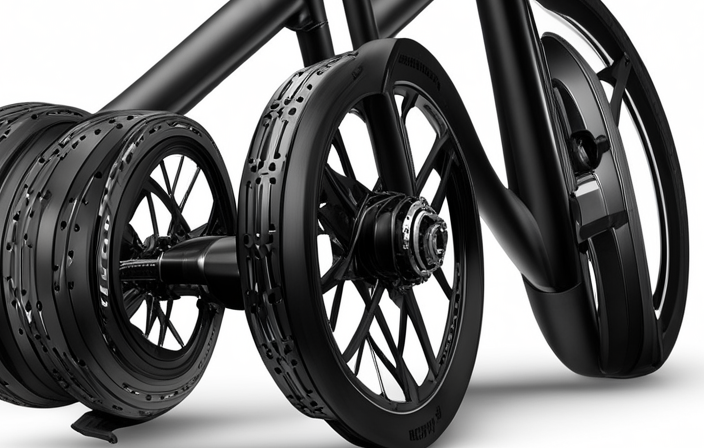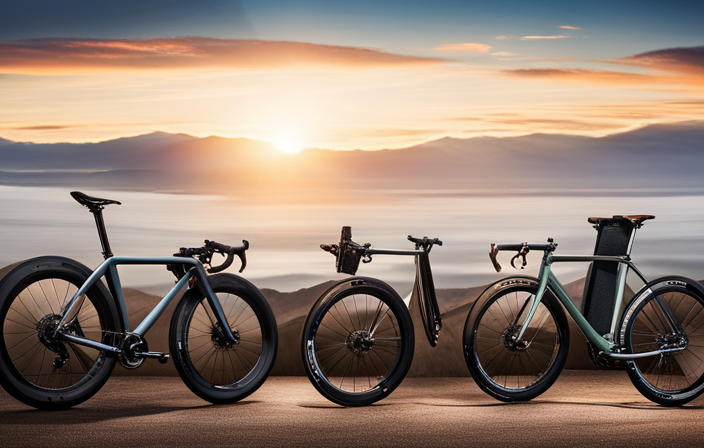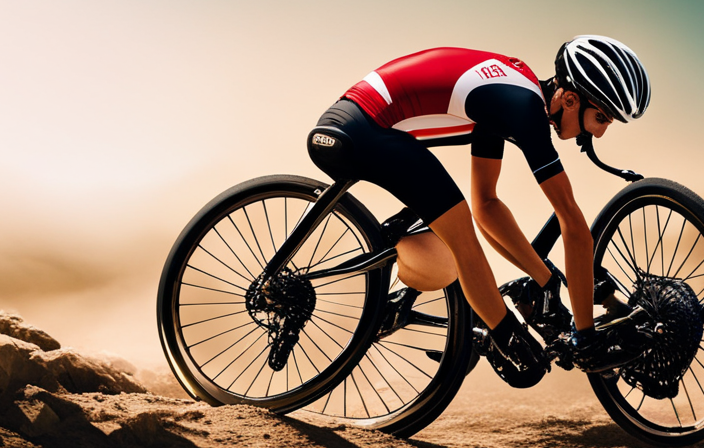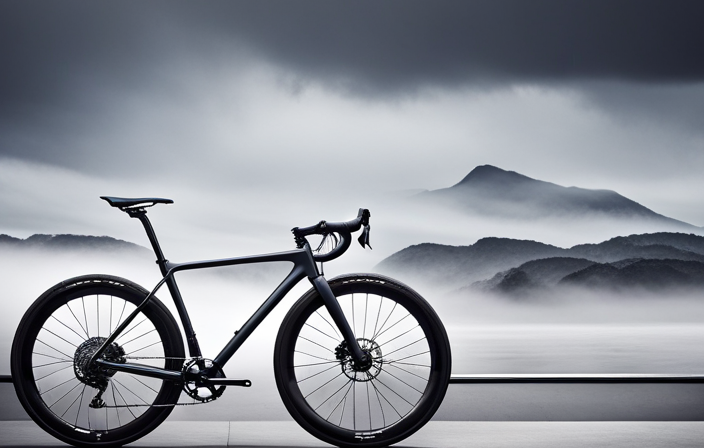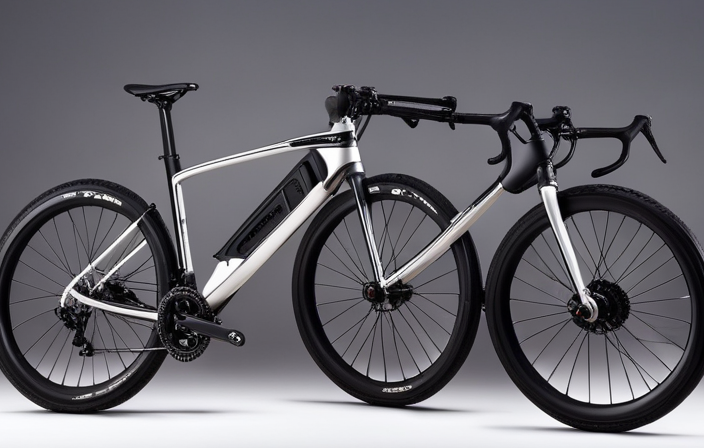Are your gravel bike tires not performing as well as you’d like? Don’t worry, fellow adventure enthusiasts! This informative article will explore components that pair well with your reliable treads.
From tire width and tread design to tubeless setups and puncture protection, we’ll leave no stone unturned. Join me on this journey as we unlock the secrets to maximizing all-terrain performance, conquering rolling resistance, and mastering handling and cornering.
So grab your helmet and saddle up – it’s time to revolutionize your gravel riding experience!
Key Takeaways
- Tire width and tread design should be considered when choosing components for gravel bike tires.
- Tubeless setup is recommended for optimal performance with gravel bike tires.
- Rim width compatibility is important for ensuring a proper fit and optimal performance with gravel bike tires.
- Components that work well with gravel bike tires should be selected for all-terrain performance and improved handling.
Tire Width and Tread Design
You’ll want to consider tire width and tread design when choosing components for your gravel bike tires. These two factors play a crucial role in determining the performance and handling of your bike on different terrains.
Firstly, let’s talk about tire width. Gravel bikes typically accommodate wider tires compared to road bikes, providing greater stability and traction on loose surfaces. The ideal tire width for gravel riding usually falls between 35mm to 45mm, although some riders may prefer even wider options for added comfort and grip. Additionally, tire pressure management is essential to optimize performance. Lowering the tire pressure increases contact area with the ground, enhancing grip on rough terrain without sacrificing too much rolling resistance.
Next up is tread design. Choosing the right tread pattern can greatly impact how your bike handles various surfaces. For instance, a more aggressive knob pattern with larger gaps between knobs performs well in muddy conditions by preventing mud buildup and maintaining traction. On the other hand, a smoother center section with smaller knobs provides better rolling efficiency on hard-packed dirt or pavement.
Considering both tire width and tread design will help you find components that maximize traction and control while minimizing rolling resistance on diverse gravel terrains.
Now let’s delve into the tubeless setup section where we explore another important aspect of gravel biking.
Tubeless Setup
To set up tubeless, start by selecting the appropriate rim tape and valve stems for your gravel bike. Rim tape is essential to seal the spoke holes in the rim bed and prevent air from escaping. Make sure to choose a tape that matches the width of your rims for a proper fit. Valve stems are responsible for allowing air into the tire and need to be compatible with tubeless setups.
Once you have the necessary components, follow these steps to install tubeless tires on your gravel bike:
- Clean and dry the inside of the rim thoroughly.
- Apply rim tape evenly around the rim bed, ensuring it covers all spoke holes.
- Insert valve stems through the valve hole in the rim, making sure they are tightly secured.
- Mount one side of the tire onto the rim, ensuring it sits evenly.
- Using a high-volume floor pump or an air compressor, inflate the tire until it seats properly on both sides of the rim.
Tubeless advantages include reduced rolling resistance, improved traction, and increased puncture resistance. The installation process can be a bit more involved than traditional tire setups but offers significant benefits in terms of performance and reliability.
Moving on to tire pressure…
Tire Pressure
Make sure you check and adjust your tire pressure regularly for optimal performance and comfort while riding. Tire pressure plays a crucial role in determining the overall performance of your gravel bike tires. The right tire pressure will not only provide better grip on various terrains but also enhance your riding experience.
When it comes to tire pressure, there are a few factors to consider. First, you need to take into account the width of your gravel bike tires. Wider tires generally require lower pressures compared to narrower ones. However, it’s important to note that different riders may prefer different pressures based on their weight, riding style, and terrain conditions.
To find the ideal tire pressure for your gravel bike, start by referring to the manufacturer’s recommendations. These guidelines usually provide a range of pressures depending on rider weight and tire size. Experimenting within this range can help you determine what works best for you.
Maintaining proper tire pressure is essential because it directly affects traction and grip while riding off-road or on loose surfaces. Higher pressures result in a harder ride with less grip, while lower pressures improve traction but may increase the risk of pinch flats or rim damage.
As we move into discussing ‘tire compound,’ it’s important to understand how different compounds interact with varying levels of tire pressure.
Tire Compound
Finding the right tire compound for your off-road adventures can greatly enhance your riding experience. When it comes to gravel bike tires, the choice of tire compound plays a crucial role in determining the overall performance and grip on different terrains.
Here are three key factors to consider when selecting a tire compound:
-
Compound hardness: The hardness of the tire compound affects its durability and grip. Softer compounds provide better traction and grip on loose surfaces like gravel or dirt, but they tend to wear out faster on pavement. Harder compounds offer longer lifespan and lower rolling resistance on smoother surfaces, but may sacrifice some grip.
-
Rubber composition: Different manufacturers use various rubber blends in their tire compounds, each with its unique characteristics. Some focus on maximizing grip, while others prioritize durability or puncture resistance. It’s important to choose a compound that aligns with your specific needs and riding style.
-
Tread pattern: The tread pattern of a tire also influences its overall performance. Aggressive tread patterns with larger knobs provide enhanced grip on loose terrain, while smoother treads excel on hard-packed surfaces.
Selecting the right tire compound can significantly improve your off-road riding experience by enhancing grip and control.
Transitioning into the next section about puncture protection, it’s essential to understand how different components work together to ensure a smooth and worry-free journey.
Puncture Protection
When it comes to adding puncture protection to my gravel bike tires, I have found that there are several effective options available.
One popular choice is the use of a puncture-resistant belt, which is typically made of materials like Kevlar or aramid fibers.
Another option is the application of a sealant inside the tire, which can help to seal small punctures as soon as they occur.
Lastly, some tire manufacturers offer specific models that are designed with built-in puncture protection features, such as an extra layer of durable rubber or a thicker tread pattern.
These different types of puncture protection can greatly reduce the likelihood of getting a flat tire while out on the trails.
Adding puncture protection to your gravel bike tires
To improve the durability of your gravel bike tires, consider adding puncture protection. Punctures are a common issue for gravel riders, and having proper protection can save you from frustrating flats on your rides.
When it comes to puncture protection methods, there is an ongoing debate between tubeless and clincher setups. Tubeless tires offer better resistance to punctures as they don’t have inner tubes that can be prone to pinches and punctures. Additionally, sealant can quickly seal small holes and prevent air leakage.
Clincher tires, on the other hand, require inner tubes but can still benefit from various puncture protection systems such as Kevlar belts or thick rubber layers under the tread. These methods add an extra layer of defense against sharp objects on the road or trail.
Moving forward, let’s explore the different types of puncture protection available for your gravel bike tires.
Without compromising performance, there are several ways to enhance the durability of your gravel bike tires by incorporating puncture protection measures into them.
Different types of puncture protection available
Consider using puncture protection measures, such as Kevlar belts or thick rubber layers, to enhance the durability of your tires.
One option for adding tire liners is to use a strip of material, typically made of Kevlar or another strong synthetic fiber, that is placed between the tire and tube. This acts as an additional barrier against sharp objects that could cause punctures.
Another method is using sealant for puncture protection. Sealant is a liquid substance that is injected into the tire and fills any small holes or cuts as they occur, sealing them off and preventing air from escaping. This can be an effective way to prevent flats caused by thorns or small debris on gravel roads.
Moving on to sidewall strength…
Sidewall Strength
You can gauge the sidewall strength of gravel bike tires by examining their construction. The rim strength and tire sidewall construction play a crucial role in determining how well the tire can withstand rough terrain and potential punctures.
When it comes to sidewall strength, there are a few key factors to consider. Firstly, the number of layers or plies in the tire’s sidewall is important. A higher number of plies generally indicates greater strength and durability. Additionally, some tires feature reinforced sidewalls that provide extra protection against cuts and abrasions.
Another aspect to look at is the material used in the sidewall construction. Some tires use lightweight materials like nylon or Kevlar, which offer good puncture resistance without adding excessive weight. Others may incorporate thicker rubber compounds for added toughness.
Furthermore, certain tire models may have additional features such as bead-to-bead protection or inserts that further enhance sidewall strength and puncture resistance.
Considering these factors will help you choose gravel bike tires with robust sidewalls that can handle demanding off-road conditions.
Moving on to rim width compatibility, it is essential to ensure that your chosen tires are suitable for your specific rim width without compromising performance or safety.
Rim Width Compatibility
When it comes to matching tire width to rim width for optimal performance on a gravel bike, there are a few key points to consider.
First and foremost, it’s important to ensure that the tire width is compatible with the rim width in order to achieve proper fit and stability.
Additionally, wider rims have several advantages for gravel biking, including improved tire support, enhanced cornering traction, and increased stability on rough terrain.
So when choosing your rims for gravel biking, make sure you take into account the ideal tire width and consider opting for wider rims to maximize your performance on the trails.
Matching tire width to rim width for optimal performance
Matching tire width to rim width is crucial for optimal performance on a gravel bike. When choosing the right tire width for your rims, there are a few factors to consider.
Improved Stability: Wider rims allow for wider tires, which provide better stability and control on rough terrain.
Enhanced Tube Compatibility: Matching tire width to rim width ensures proper tube fitment, reducing the risk of pinch flats and improving overall ride quality.
Increased Traction: The wider contact patch between the tire and road surface enhances traction, especially when cornering or riding in loose conditions.
Considering these factors will help you select the perfect tire width for your gravel bike’s rims.
Now let’s explore the advantages of wider rims for gravel biking.
Advantages of wider rims for gravel biking
Optimal performance on a gravel bike can be achieved by utilizing wider rims, which offer several advantages. When it comes to rim width, there is a direct relationship with tire width that should be considered for the best riding experience. Wider rims provide more support for wider tires, allowing them to maintain their shape and stability even at lower pressures. This results in increased traction and control on rough terrain, enhancing the overall ride quality.
To further illustrate the benefits of wider rims for gravel biking, let’s take a look at the following table:
| Rim Width (mm) | Tire Width Range (mm) |
|---|---|
| 19-21 | 28-42 |
| 22-24 | 40-50 |
| 25+ | 48+ |
As you can see, wider rims accommodate wider tire widths, unlocking additional benefits such as improved cornering grip and reduced rolling resistance. It’s important to find the right balance between rim width and tire width to maximize your gravel biking experience.
Moving forward to discuss tube compatibility…
Tube Compatibility
To determine tube compatibility for your gravel bike tires, you should consider using a valve type that works with your rims. There are two common types of valve stems: Presta and Schrader. Presta valves are slender and require a smaller hole in the rim, making them suitable for most gravel bike rims. On the other hand, Schrader valves are thicker and typically found on mountain bikes or hybrid models.
Once you have chosen the appropriate valve type, it is important to ensure that your tubes are compatible with sealant if you plan to use it. Some tubes come pre-filled with sealant, while others may require patching in case of punctures. It is crucial to check whether the sealant you intend to use is compatible with the tube material to avoid potential issues.
Now that we have covered tube compatibility, let’s move on to discussing tire durability. It is essential to choose tires that can withstand the challenging conditions often encountered during gravel biking adventures.
Tire Durability
When choosing tires for your gravel adventures, it’s important to consider their durability. Gravel riding can be tough on tires, so you want to make sure you choose ones that can withstand the demands of rough terrain. Here are some factors to consider when evaluating the durability of gravel bike tires:
-
Tire Life Expectancy: Look for tires that have a long life expectancy. This means they will last longer before needing to be replaced, saving you money in the long run.
-
Tire Wear Patterns: Pay attention to how the tire wears over time. Some tires may wear unevenly, which can affect their performance and lifespan. Look for even wear patterns across the entire surface of the tire.
-
Puncture Resistance: Gravel roads often feature sharp rocks and debris that can cause punctures. Choose tires with good puncture resistance to minimize the risk of flats.
-
Sidewall Protection: The sidewalls of gravel bike tires are prone to damage from rocks and other hazards. Opt for tires with reinforced sidewalls for added protection against cuts and abrasions.
Considering these factors will help you select durable gravel bike tires that can handle the challenges of off-road riding.
Now let’s transition into discussing weight considerations when choosing gravel bike components without missing a beat.
Weight Considerations
When it comes to tire durability, weight considerations play a significant role. As a gravel bike enthusiast myself, I understand the importance of finding the perfect balance between weight distribution and impact resistance. Gravel riding often involves tackling various terrains, from smooth roads to rocky trails, and having tires that can withstand these different conditions is crucial.
Weight distribution is essential because it affects how your bike handles and performs. Lighter tires can provide a more nimble and responsive ride, allowing you to maneuver through obstacles with ease. However, it’s important not to sacrifice too much durability for weight savings. You want tires that can handle the rough terrain without compromising on reliability.
Impact resistance is another key factor to consider when choosing components for your gravel bike tires. Gravel roads can be unpredictable, with potholes and sharp rocks posing potential hazards. Having tires that are designed to withstand impacts will give you peace of mind while riding.
In the next section about ‘gravel-specific tires,’ we will delve deeper into the specific features and benefits of these specialized components.
Gravel-specific Tires
Gravel-specific tires offer specialized features and benefits that enhance performance on various terrains. When it comes to gravel biking, the tubeless vs. clincher debate is a common topic of discussion.
Tubeless tires have gained popularity due to their ability to run at lower pressures without the risk of pinch flats. This feature provides increased traction and comfort on rough terrain. On the other hand, clincher tires are more traditional and use an inner tube for inflation. They are easier to install and repair, but may be more prone to punctures.
In terms of tire brands, there are several top contenders in the gravel biking world. One popular brand is WTB, known for their durable and versatile tires that excel on mixed surfaces. Another well-regarded option is Panaracer, offering high-performance gravel tires with excellent grip and durability.
Transitioning into the next section about all-terrain performance, it’s important to consider how these gravel-specific tires perform across different surfaces such as loose gravel, mud, or pavement. These specialized tires are designed to handle a variety of conditions while providing optimal grip and control for riders.
Overall, choosing the right gravel-specific tire depends on personal preference and riding style. Whether you opt for tubeless or clincher, selecting one from reputable brands like WTB or Panaracer will ensure a reliable and enjoyable gravel biking experience.
All-terrain Performance
Now that we have discussed gravel-specific tires, let’s delve into the all-terrain performance they offer.
One of the key advantages of these tires is their exceptional versatility across different terrains. Whether you’re riding on loose gravel, muddy trails, or even pavement, these tires can handle it all with ease.
The secret behind this all-terrain prowess lies in the tire grip and traction they provide. Gravel-specific tires are designed with a tread pattern that features aggressive knobs and lugs. These deep treads dig into the ground, providing excellent traction on loose surfaces like gravel and dirt. Additionally, the wider profile of these tires enhances stability and control when navigating tricky terrain.
Furthermore, these tires often incorporate specialized rubber compounds that offer enhanced grip in both wet and dry conditions. This means you can confidently tackle any trail or road surface without worrying about losing traction.
As we transition to discussing rolling resistance in the next section, it’s important to note that while gravel-specific tires excel in all-terrain versatility and tire grip, they may have slightly higher rolling resistance compared to smoother road-oriented options. However, this trade-off is well worth it for riders who prioritize off-road capability and confidence-inspiring performance.
Rolling Resistance
One thing to consider is that these tires may have a slightly higher rolling resistance compared to smoother road-oriented options. The increased tread pattern and larger volume of the gravel bike tires can result in more surface area making contact with the ground, which can cause a slight decrease in tire rolling speed. However, this trade-off is necessary to ensure optimal tire grip on various terrains.
Tire grip is crucial when riding on gravel or off-road surfaces. The deeper and more aggressive tread patterns found on gravel bike tires help to enhance traction by providing more points of contact with the ground. This allows for better control and stability when navigating loose or uneven surfaces.
While the rolling resistance may be slightly higher, it’s important to note that modern gravel bike tires are designed with advancements in rubber compounds and tread patterns that aim to minimize this effect as much as possible. Manufacturers strive for a balance between grip and efficiency.
In conclusion, although gravel bike tires may have a slightly higher rolling resistance compared to road-oriented options, they offer superior tire grip on various terrains. This compromise ensures better control and stability while riding off-road.
Moving forward into the next section about handling and cornering, it’s important to understand how these factors interact with tire performance overall.
Handling and Cornering
To improve your handling and cornering on different terrains, it’s important to consider the performance of your tires. One key factor to consider is the width of your tires. Wider tires offer several advantages when it comes to handling and cornering.
Firstly, wider tires provide a larger contact patch with the ground, which increases traction and stability. This allows you to maintain control while navigating tight corners or loose gravel surfaces. Additionally, wider tires also absorb more shocks and vibrations from uneven terrain, resulting in a smoother ride and improved handling.
Another advantage of wider tires is their ability to handle lower tire pressures. By running lower pressures, you can increase the tire’s grip on the road or trail, especially during cornering maneuvers. This increased grip translates into better control and enhanced confidence while tackling challenging turns.
Improving your cornering skills also involves proper body positioning and technique. It’s crucial to shift your weight towards the outside pedal when taking corners, as this helps to maintain balance and stability throughout the maneuver. Additionally, practicing proper braking techniques before entering a turn can greatly enhance your ability to navigate corners effectively.
In conclusion, choosing wider tires for your gravel bike can significantly improve your handling and cornering skills by providing increased traction, stability, and shock absorption capabilities.
Now let’s move on to discussing maintenance and care for optimal tire performance without sacrificing durability or lifespan.
Maintenance and Care
Regular maintenance is crucial for optimal performance and longevity of gravel bike tires. As a gravel cyclist, I prioritize regular tire inspections. This includes checking tread depth, looking for cuts or punctures, and ensuring proper inflation levels. If any issues arise, such as sidewall damage or a flat tire, I promptly address them by patching or replacing the tire. This ensures the best riding experience on rough terrain.
Regular maintenance for gravel bike tires
Make sure you regularly check and inflate your gravel bike tires to ensure proper maintenance. This will help prevent any potential issues and extend the lifespan of your tires. In addition to regular checks and inflation, there are a few other maintenance tasks to keep in mind. First, consider using tire sealant to prevent punctures and improve overall durability. This can be applied during installation or injected through the valve stem. Second, rotating your tires periodically will help even out wear and prolong their life. To engage the audience further, here’s a table summarizing these maintenance tasks:
| Maintenance Task | Frequency |
|---|---|
| Check tire pressure | Before each ride |
| Inflate as needed | Weekly |
| Apply tire sealant | During installation or as needed |
| Rotate tires | Every 500-750 miles |
By following these regular maintenance practices, you can ensure that your gravel bike tires perform optimally for longer periods of time. Moving on to inspecting and repairing damaged tires…
How to inspect and repair damaged tires
Ensure you inspect your tires regularly for any signs of damage and promptly repair them to maintain optimal performance. To patch a tire, start by removing the wheel from the bike. Deflate the tire completely and inspect it for any punctures or cuts. Use soapy water to identify leaks, as bubbles will form where air is escaping. Once you locate the damaged area, clean it thoroughly with rubbing alcohol and let it dry. Apply a patch kit specifically designed for bicycle tires, ensuring it covers the entire damaged area. Press firmly to ensure proper adhesion. After applying the patch, inflate the tire slowly and check for any additional leaks. Lastly, reattach the wheel to your bike and enjoy smooth riding once again.
- Inspecting for wear and tear:
Regularly check your tire tread depth using a coin or tread gauge.
Look for cracks or bulges in the sidewall that may indicate internal damage.
Inspect the bead area where the tire meets the rim for any signs of separation or fraying.
Frequently Asked Questions
Can I use a gravel bike tire on a road bike?
Yes, you can use gravel bike tires on a road bike. Gravel bike tires can improve performance on a road bike in certain situations. They provide increased traction and stability on rough or wet roads, making them ideal for riding in unpredictable conditions.
However, there are some disadvantages to consider. Gravel tires typically have more rolling resistance, which can slow you down on smooth pavement. Additionally, they may not provide the same level of efficiency as road-specific tires.
How often should I replace my gravel bike tires?
Replacing gravel bike tires is crucial for optimal performance and safety. To choose the right tire width, consider your riding style and terrain. Wider tires offer more stability on loose surfaces, while narrower ones provide better speed on smoother roads.
Additionally, regularly inspecting your tires for wear indicators and maintaining proper tire pressure will extend their lifespan. Remember, investing in high-quality tires and rotating them periodically will ensure a smooth and enjoyable gravel biking experience.
What is the difference between tubeless and tubed tires for gravel bikes?
The difference between tubeless and tubed tires for gravel bikes lies in their construction and performance.
Tubeless tires, as the name suggests, do not require an inner tube and instead rely on airtight sealing to hold air. This design offers advantages such as reduced punctures, lower rolling resistance, and the ability to run at lower pressures for increased traction.
On the other hand, tubed tires use an inner tube to hold air and are generally more affordable but may be prone to pinch flats.
Are there any specific tire brands or models that are highly recommended for gravel biking?
When it comes to highly recommended tire brands or models for gravel biking, there are a few options worth considering. Some popular choices include the Schwalbe G-One, WTB Nano, and Panaracer Gravelking. These tires offer excellent traction on loose surfaces and provide a comfortable ride.
However, wider gravel bike tires also have some downsides. They can be heavier and slower on smooth pavement, and they may not fit all bike frames or have clearance issues with certain components.
When choosing gravel bike tires, factors to consider include terrain conditions, desired level of grip versus speed, durability, and compatibility with your bike frame and components.
Can I use mountain bike tires on a gravel bike?
Yes, you can use mountain bike tires on a gravel bike. One advantage of using wider tires on a gravel bike is increased stability and traction. Wider tires provide a larger contact patch with the ground, allowing for better grip in loose or uneven terrain.
When choosing tire tread for gravel biking, consider a pattern with more aggressive knobs or lugs to handle various off-road conditions. It’s important to find the right balance between rolling resistance and grip for optimal performance.
Conclusion
In conclusion, when it comes to gravel bike tires, the components that work together seamlessly create a symphony of performance.
The tire width and tread design provide stability and grip on various terrains, while the tubeless setup ensures a smoother ride with reduced risk of flats.
Tire pressure and compound are crucial in finding the perfect balance between comfort and speed. Puncture protection is like armor for your tires, defending against sharp objects lurking on gravel roads.
All-terrain performance guarantees versatility for any adventure. Rolling resistance determines how effortlessly you glide along the path, while handling and cornering capabilities give you confidence in every turn.
And lastly, maintenance and care ensure longevity and optimal performance of your beloved gravel bike tires. So choose wisely, as these components will be your steadfast companions on countless thrilling journeys through rugged landscapes and untamed wildernesses.
